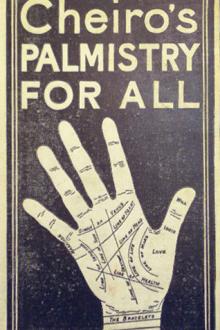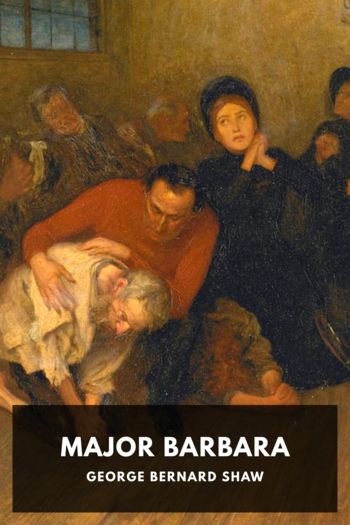Palmistry for All by Cheiro (free reads TXT) 📕

- Author: Cheiro
- Performer: -
Book online «Palmistry for All by Cheiro (free reads TXT) 📕». Author Cheiro
The Philosophic Hand is one of the highest developments of the mental side of the human family.
THE CONIC OR ARTISTIC HANDThe Conic, also called the Artistic, Hand (Plate II., Part II.), is always graceful looking, with the fingers tapering and pointed. It has, not only on account of its appearance but also because of the qualities it represents, been called the Artistic Hand.
Its possessor may not always paint pictures or design beautiful things, but he will have the emotional, artistic temperament, which loves beautiful surroundings, and is most sensitive to colour, music, and all the fine arts. It largely depends on the kind of Head Line and the will power shown by it, to determine whether its owner will develop the natural artistic temperament that he or she possesses.
Such hands being generally full, fleshy, or soft, there is always a decidedly pronounced indolence in the nature which, if not overcome, combats the hard work necessary to achieve any real result. All very emotional people have more or less the characteristics of this type, but great numbers simply squander their time in the appreciation of art, rather than in making the effort in themselves to create it.
The harder and firmer this type of hand is, the more likely it is to find that its possessor will really make something out of his artistic temperament.
THE PSYCHIC OR IDEALISTIC HANDThis type (Plate II., Part II.), may in many ways be considered as the highest development of the hand on the purely mental plane, but from a worldly standpoint it is the least successful of all. Its possessors live in a world of dreams and ideals. They know little or nothing about the practical or purely material side of existence, and when they have to earn their own bread they gain so little that they usually starve.
These beautiful hands do not appear made for work in any sense. They are also too spiritual and frail to deal blows and hold their own in the battle of life. If they are supported by others, or have money of their own to live on, all may be well, and in such cases they will be likely to develop strange psychic gifts dealing with visions and ideals that some few may hear and understand. But if not, their fate as a rule is a sad one, they will easily be pushed aside by the rougher types of humanity or, in sheer helplessness, take their own lives, and so end the unequal struggle.
In constitution they are seldom strong physically, and consequently they are doubly unfitted for the struggle for existence.
THE MIXED HANDWhat is called the "Mixed Hand" (Plate II., Part II.), is an aggregation of all the types, or at least, some of them.
It is very often found having all the fingers different from one another, as for example one pointed, one square, or spatulate, and so on. Or sometimes the palm may be of one type, say spatulate, with all the fingers mixed.
Such persons are always versatility itself, but so changeable in purpose that they rarely succeed in making much out of any talents they may possess. They can generally do a little of everything but nothing well. They can talk on any subject that may crop up, but never impress their listeners with depth of thought on any subject.
It is only when the Line of Head is found on such hands clear and straight that there is a likelihood of these persons developing some one talent out of the versatility that this type gives.
CHAPTER II THE THUMBIn the judgment of character by the formation of the Hand, the Thumb is of about the same importance as the nose is to the face. It must be understood to represent the natural Will Power, whereas the Line of Head represents the Mental Will.
In my larger works on this subject I have gone into very deeply the medical reasons why character should be expressed by the Thumb and the extraordinary rôle it has played in civilisation, and also in the various religions of the world.
The Thumb proper represents the three great worlds of ideas, viz., Love, Logic, and Will (Plate VI., Part II.).
Love is represented by the base of the Thumb which is covered on the hand by the Mount of Venus.
Logic is the middle phalange, and Will is the top or nail portion.
When these divisions are found large, the qualities are increased; when small, they play a smaller rôle in the life of the individual.
There are two distinct classes of Thumbs, the supple-jointed and the firm-jointed.
The former of these divisions is the Thumb bending outwards and supple at the joint underneath the nail (Fig. 2, Plate III.).
This denotes a nature pliable and adaptable to others, very broad-minded, rather unconventional, and not obstinate in its views of life. These characteristics will be increased if the Head Line be found sloping and bending downwards. If, however, the Line of Head be found lying straight across the palm, they are more conventional. The "supple-jointed" thumb also denotes generosity of mind both as regards thought and money. In all ways these people are more extravagant than people who have the straight firm-jointed thumb. In other words they "give more" even in what they think as well as in what they do.
The nearer the Thumb approaches the side of the hand, or the more it looks tied down or cramped to the palm, the more the subject is inclined to grasp or hold. The true miser has always a thumb cramped towards the hand, and the nail phalange as a rule slightly turned in, as if the mind wanted to grab hold or retain.
The supple-jointed Thumb is more impulsive in its desire to give than is the stiff-jointed class, whereas the latter type demands reflection before he even gives an opinion.
If a favour should be asked of the man with the supple-jointed Thumb, one should remember that he is more inclined to give in on the impulse of the moment, and if one does not press one's point home at once, he is likely first to promise, and later, on reflection, change his mind.
The man with the stiff-jointed Thumb (Fig. 3, Plate III.) on the contrary, is more likely to refuse at first and on reflection to agree to the proposition; but it he does make up his mind, he will stick to his judgment or opinion, and the more he is opposed the more determined he will be to hold to his view.
Fig. 3.—THE FIRM-JOINTED THUMB.
Fig. 5.—THE STRAIGHT THUMB.
Fig. 6.—THE ELEMENTARY THUMB.
Plate III.— Part II.
The firm-jointed thumb is then the outward sign of a more resisting nature, and the longer the first or nail phalange is, the stronger and more powerful the Will force.
These people seldom make friends so easily or rapidly as those belonging to the other type. On a railway journey they rarely begin a conversation with a fellow traveller, and if they have to do so it will generally be in the form of an argument that "the window must be left open or shut," as the case may be. Heaven help the other poor traveller if he should also happen to have a stiff thumb, and oppose his ideas to those of the first.
The supple-jointed class, on the contrary, enter readily into conversation with strangers, and they often make their greatest friends while travelling. They are affable, charming companions, and give in readily to the wishes of others. In fact, this quality inclines to a weakness that should be guarded against. Among all those men and women who take the "easiest way" a large majority will be found to have very supple-jointed thumbs. This, however, will be greatly qualified by the position and appearance of the Line of Head, the indicator of the developed mental Will.
To have a supple lower or middle joint does not relate to the Will but to the phalange of Logic of the possessor. When this second joint is found supple the subject adapts himself to circumstances rather than to persons. He reasons out that he must bend or adapt himself to the conditions or circumstances of the life in which he is placed.
The Clubbed Thumb (Fig. 1, Plate III.), is so called from its being thick like a club. People possessing this class of Thumb belong to the Elementary type as far as Will is concerned. They are brutal and like animals in their unreasonable obstinacy. If they are opposed they fly into ungovernable passions and blind rages. They have no control over themselves, and are liable to go to any extreme of violence or crime during one of their tempers. In fact the clubbed-shaped Thumb has also been designated "the murderer's thumb" on account of so many murderers having been found with this formation.
The possessor of a Clubbed Thumb could not, however, plan out or premeditate a crime, for he would not have the determined Will or power of reason to think it out.
The shorter the Thumb, the nearer the possessor is to the brute in passion and lack of self-control.
The "waist-like" Thumb (Fig. 4, Plate III.), and the "straight" formation (Fig. 5), must also be considered as the opposite of one another in their characteristics, but in this case the difference is in the quality of Logic or Reason. The former will not use or depend much on such things, he will rely, on the contrary, on tact and diplomacy to gain his point or win his way. The second class have little or no tact, but in all matters depend on argument and reason.
The third phalange of the Thumb, which is placed under the designation of Love (Plate VI., Part II.), when found long, denotes more control over the quality of Love or Sensuality; when short and thick-set, the passion or sensual nature is more brutal and animal.
The space at my disposal in this work will not allow me to go deeper into all the shades of character that can be made out by a study of the Thumb alone, but I think I have said enough to show my readers the great truth in D'Arpentigny's words that "the Thumb individualises the man."
CHAPTER III THE FINGERS—LENGTH TO ONE ANOTHER THE SMOOTH AND THE KNOTTYThe First Finger is called the Finger of Jupiter.
The Second is called the Finger of Saturn.
The Third is called the Finger of The Sun.
The Fourth is called the Finger of Mercury.
The Finger of Jupiter, when long, gives love of power and command over others. When short it denotes dislike of responsibility and lack of ambition.
The Finger of Saturn when long gives prudence, love of solitude and a reserved, studious disposition. When short it denotes frivolity and general lack of seriousness in all things.
The Finger of the Sun when long gives love of the beautiful, desire for celebrity and fame, but when excessively long, the tendency inclines more toward notoriety, risk in speculation, the love of money and gambling. When short it denotes a dislike of all these things.
The





Comments (0)